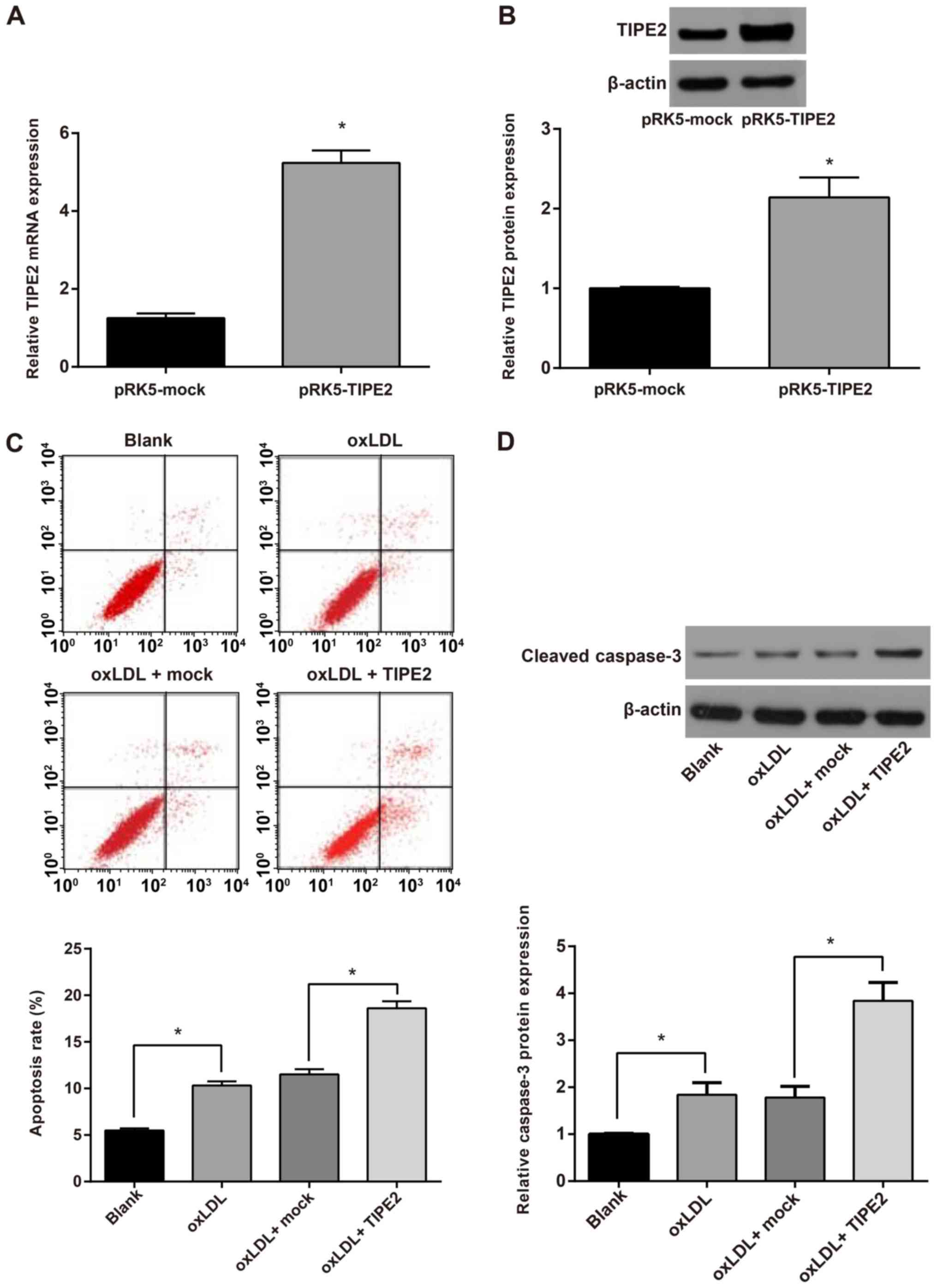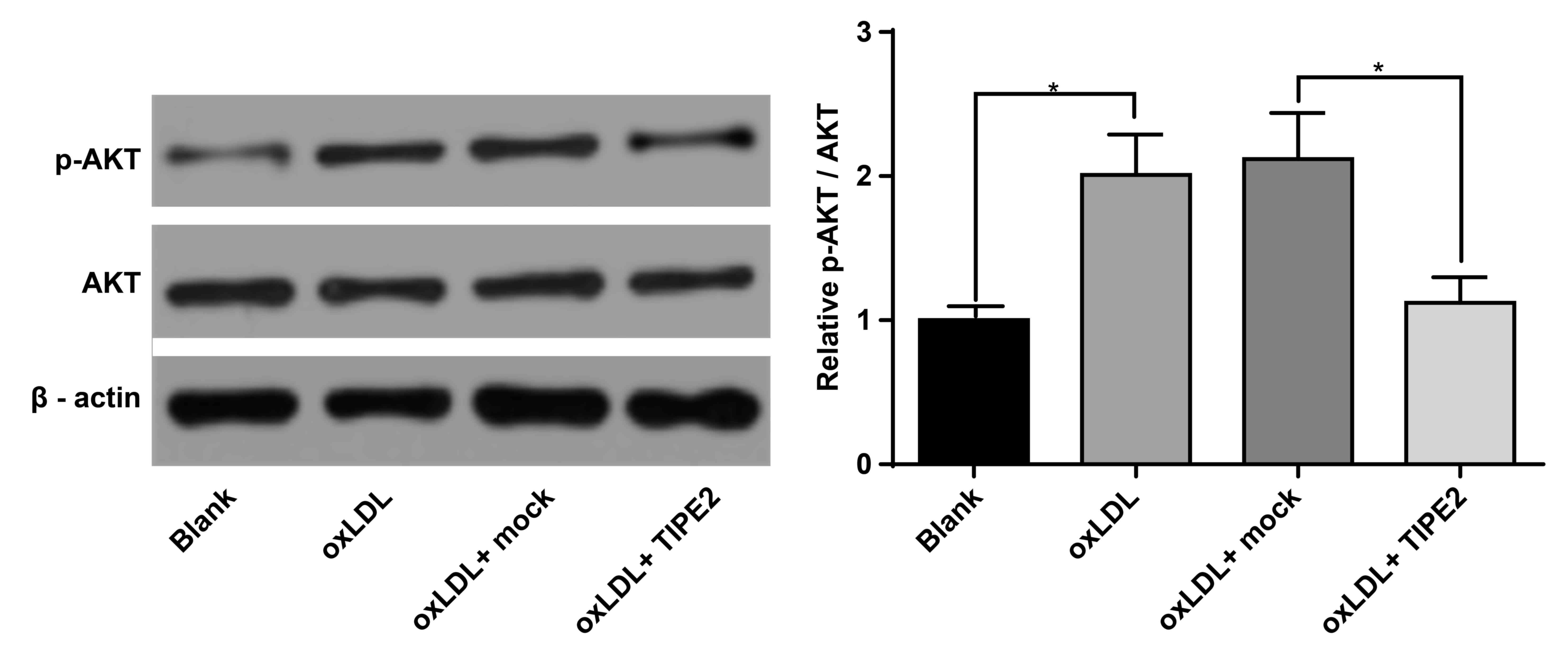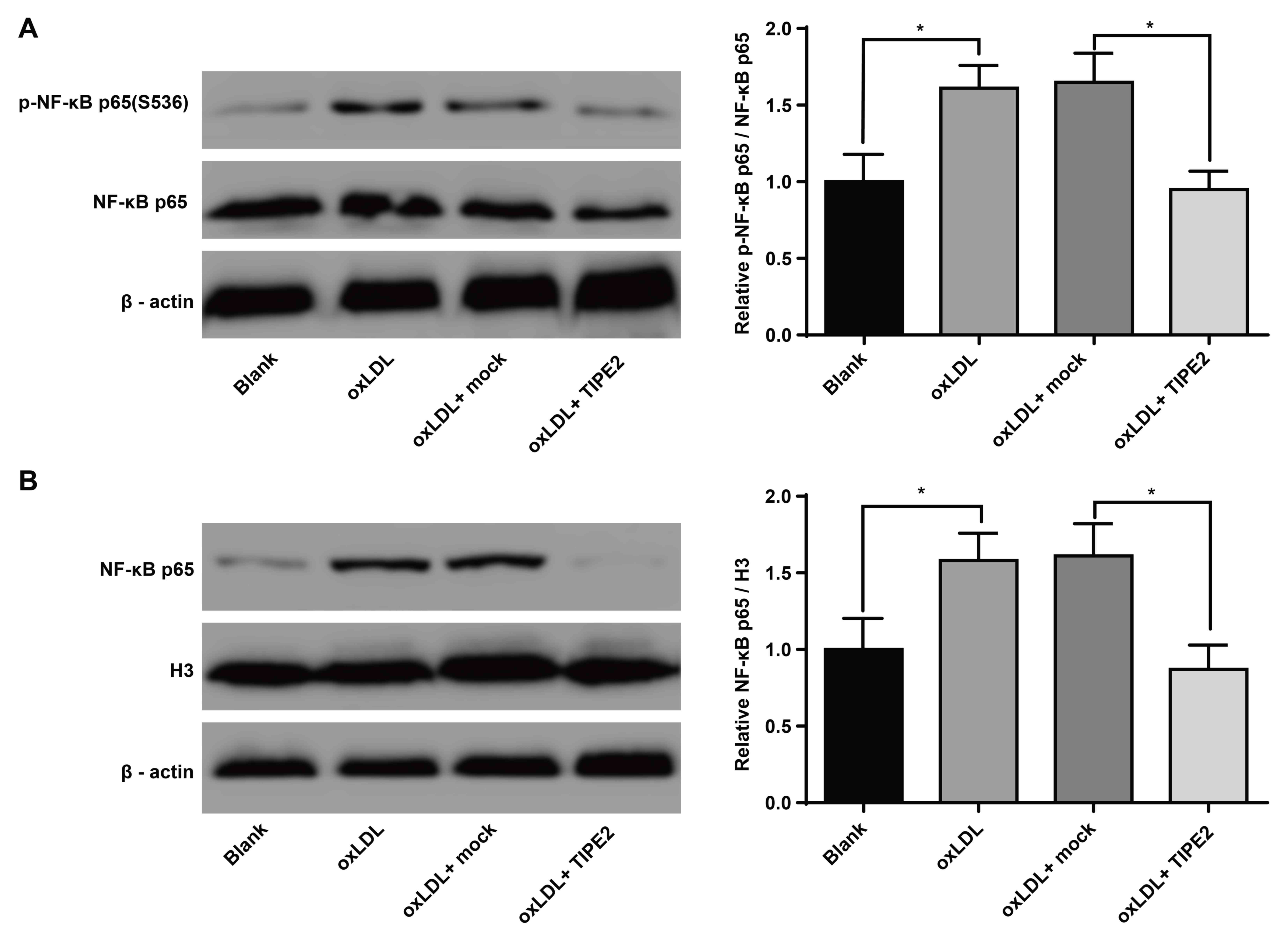|
1
|
Viola J and Soehnlein O: Atherosclerosis-A
matter of unresolved inflammation. Semin Immunol. 27:184–193. 2015.
View Article : Google Scholar : PubMed/NCBI
|
|
2
|
Tabas I, García-Cardeña G and Owens GK:
Recent insights into the cellular biology of atherosclerosis. J
Cell Biol. 209:13–22. 2015. View Article : Google Scholar : PubMed/NCBI
|
|
3
|
Libby P, Ridker PM and Hansson GK:
Progress and challenges in translating the biology of
atherosclerosis. Nature. 473:317–325. 2011. View Article : Google Scholar : PubMed/NCBI
|
|
4
|
Gui T, Shimokado A, Sun Y, Akasaka T and
Muragaki Y: Diverse roles of macrophages in atherosclerosis: From
inflammatory biology to biomarker discovery. Mediators Inflamm.
2012:6930832012. View Article : Google Scholar : PubMed/NCBI
|
|
5
|
Wang Y, Han Z, Fan Y, Zhang J, Chen K, Gao
L, Zeng H, Cao J and Wang C: MicroRNA-9 inhibits NLRP3 inflammasome
activation in human atherosclerosis inflammation cell models
through the JAK1/STAT signaling pathway. Cell Physiol Biochem.
41:1555–1571. 2017. View Article : Google Scholar : PubMed/NCBI
|
|
6
|
Zhang E and Wu Y: MicroRNAs: Important
modulators of oxLDL-mediated signaling in atherosclerosis. J
Atheroscler Thromb. 20:215–227. 2013. View Article : Google Scholar : PubMed/NCBI
|
|
7
|
Wang H and Eitzman DT: Acute myocardial
infarction leads to acceleration of atherosclerosis.
Atherosclerosis. 229:18–22. 2013. View Article : Google Scholar : PubMed/NCBI
|
|
8
|
Libby P: Inflammation in atherosclerosis.
Arterioscler Thromb Vasc Biol. 32:2045–2051. 2012. View Article : Google Scholar : PubMed/NCBI
|
|
9
|
Sun H, Gong S, Carmody RJ, Hilliard A, Li
L, Sun J, Kong L, Xu L, Hilliard B, Hu S, et al: TIPE2, a negative
regulator of innate and adaptive immunity that maintains immune
homeostasis. Cell. 133:415–426. 2008. View Article : Google Scholar : PubMed/NCBI
|
|
10
|
Xi W, Hu Y, Liu Y, Zhang J, Wang L, Lou Y,
Qu Z, Cui J, Zhang G, Liang X, et al: Roles of TIPE2 in hepatitis B
virus-induced hepatic inflammation in humans and mice. Mol Immunol.
48:1203–1208. 2011. View Article : Google Scholar : PubMed/NCBI
|
|
11
|
Li F, Zhu X, Yang Y, Huang L and Xu J:
TIPE2 alleviates systemic lupus erythematosus through regulating
macrophage polarization. Cell Physiol Biochem. 38:330–339. 2016.
View Article : Google Scholar : PubMed/NCBI
|
|
12
|
Ma Y, Liu X, Wei Z and Wang X, Wang Z,
Zhong W, Li Y, Zhu F, Guo C, Zhang L and Wang X: The expression and
significance of TIPE2 in peripheral blood mononuclear cells from
asthmatic children. Scand J Immunol. 78:523–528. 2013. View Article : Google Scholar : PubMed/NCBI
|
|
13
|
Zhang Y, Wei X, Liu L, Liu S, Wang Z,
Zhang B, Fan B, Yang F, Huang S, Jiang F, et al: TIPE2, a novel
regulator of immunity, protects against experimental stroke. J Biol
Chem. 287:32546–32555. 2012. View Article : Google Scholar : PubMed/NCBI
|
|
14
|
Liu R, Fan T, Geng W, Chen YH, Ruan Q and
Zhang C: Negative immune regulator TIPE2 promotes M2 macrophage
differentiation through the activation of PI3K-AKT signaling
pathway. PLoS One. 12:e01706662017. View Article : Google Scholar : PubMed/NCBI
|
|
15
|
Livak KJ and Schmittgen TD: Analysis of
relative gene expression data using real-time quantitative PCR and
the 2(-Delta Delta C(T)) method. Methods. 25:402–408. 2001.
View Article : Google Scholar : PubMed/NCBI
|
|
16
|
Follo MY, Manzoli L, Poli A, McCubrey JA
and Cocco L: PLC and PI3K/Akt/mTOR signalling in disease and
cancer. Adv Biol Regul. 57:10–16. 2015. View Article : Google Scholar : PubMed/NCBI
|
|
17
|
Liu YC, Zou XB, Chai YF and Yao YM:
Macrophage polarization in inflammatory diseases. Int J Biol Sci.
10:520–529. 2014. View Article : Google Scholar : PubMed/NCBI
|
|
18
|
Wang Y, Wang GZ, Rabinovitch PS and Tabas
I: Macrophage mitochondrial oxidative stress promotes
atherosclerosis and nuclear factor-κB-mediated inflammation in
macrophages. Circ Res. 114:421–433. 2014. View Article : Google Scholar : PubMed/NCBI
|
|
19
|
Taleb S, Tedgui A and Mallat Z: IL-17 and
Th17 cells in atherosclerosis: Subtle and contextual roles.
Arterioscler Thromb Vasc Biol. 35:258–264. 2015. View Article : Google Scholar : PubMed/NCBI
|
|
20
|
Shao BZ, Han BZ, Zeng YX, Su DF and Liu C:
The roles of macrophage autophagy in atherosclerosis. Acta
Pharmacol Sin. 37:150–156. 2016. View Article : Google Scholar : PubMed/NCBI
|
|
21
|
Tabas I and Bornfeldt KE: Macrophage
phenotype and function in different stages of atherosclerosis. Circ
Res. 118:653–667. 2016. View Article : Google Scholar : PubMed/NCBI
|
|
22
|
Linton MF, Babaev VR, Huang J, Linton EF,
Tao H and Yancey PG: Macrophage apoptosis and efferocytosis in the
pathogenesis of atherosclerosis. Circ J. 80:2259–2268. 2016.
View Article : Google Scholar : PubMed/NCBI
|
|
23
|
Aflaki E, Balenga NA, Luschnig-Schratl P,
Wolinski H, Povoden S, Chandak PG, Bogner-Strauss JG, Eder S, Konya
V, Kohlwein SD, et al: Impaired Rho GTPase activation abrogates
cell polarization and migration in macrophages with defective
lipolysis. Cell Mol Life Sci. 68:3933–3947. 2011. View Article : Google Scholar : PubMed/NCBI
|
|
24
|
Martinez FO, Sica A, Mantovani A and
Locati M: Macrophage activation and polarization. Front Biosci.
13:453–461. 2008. View
Article : Google Scholar : PubMed/NCBI
|
|
25
|
Smith JD, Trogan E, Ginsberg M, Grigaux C,
Tian J and Miyata M: Decreased atherosclerosis in mice deficient in
both macrophage colony-stimulating factor (op) and apolipoprotein
E. Proc Natl Acad Sci USA. 92:8264–8268. 1995. View Article : Google Scholar : PubMed/NCBI
|
|
26
|
Green CE, Liu T, Montel V, Hsiao G, Lester
RD, Subramaniam S, Gonias SL and Klemke RL: Chemoattractant
signaling between tumor cells and macrophages regulates cancer cell
migration, metastasis and neovascularization. PLoS One.
4:e67132009. View Article : Google Scholar : PubMed/NCBI
|
|
27
|
Mantovani A and Sica A: Macrophages,
innate immunity and cancer: Balance, tolerance, and diversity. Curr
Opin Immunol. 22:231–237. 2010. View Article : Google Scholar : PubMed/NCBI
|
|
28
|
Hao C, Zhang N, Geng M, Ren Q, Li Y, Wang
Y, Chen YH and Liu S: Clinical significance of tipe2 protein
upregulation in non-Hodgkin's Lymphoma. J Histochem Cytochem.
64:556–564. 2016. View Article : Google Scholar : PubMed/NCBI
|
|
29
|
Garcia JA, Ferreira HL, Vieira FV, Gameiro
R, Andrade AL, Eugênio FR, Flores EF and Cardoso TC: Tumour
necrosis factor-alpha-induced protein 8 (TNFAIP8) expression
associated with cell survival and death in cancer cell lines
infected with canine distemper virus. Vet Comp Oncol. 15:336–344.
2017. View Article : Google Scholar : PubMed/NCBI
|
|
30
|
Wang Z, Fayngerts S, Wang P, Sun H,
Johnson DS, Ruan Q, Guo W and Chen YH: TIPE2 protein serves as a
negative regulator of phagocytosis and oxidative burst during
infection. Proc Natl Acad Sci USA. 109:15413–15418. 2012.
View Article : Google Scholar : PubMed/NCBI
|
|
31
|
Lou Y, Liu S, Zhang C, Zhang G, Li J, Ni
M, An G, Dong M, Liu X, Zhu F, et al: Enhanced atherosclerosis in
TIPE2-deficient mice is associated with increased macrophage
responses to oxidized low-density lipoprotein. J Immunol.
191:4849–4857. 2013. View Article : Google Scholar : PubMed/NCBI
|
|
32
|
Janabi M, Yamashita S, Hirano K, Sakai N,
Hiraoka H, Matsumoto K, Zhang Z, Nozaki S and Matsuzawa Y: Oxidized
LDL-induced NF-kappa B activation and subsequent expression of
proinflammatory genes are defective in monocyte-derived macrophages
from CD36-deficient patients. Arterioscler Thromb Vasc Biol.
20:1953–1960. 2000. View Article : Google Scholar : PubMed/NCBI
|
|
33
|
Zhang M, Liu J, Li M, Zhang S, Lu Y, Liang
Y, Zhao K and Li Y: Insulin-like growth factor 1/insulin-like
growth factor 1 receptor signaling protects against cell apoptosis
through the PI3K/AKT pathway in glioblastoma cells. Exp Ther Med.
16:1477–1482. 2018.PubMed/NCBI
|
|
34
|
Liu S, Shen H, Xu M, Liu O, Zhao L, Liu S,
Guo Z and Du J: FRP inhibits ox-LDL-induced endothelial cell
apoptosis through an Akt-NF-{kappa}B-Bcl-2 pathway and inhibits
endothelial cell apoptosis in an apoE-knockout mouse model. Am J
Physiol Endocrinol Metab. 299:E351–E363. 2010. View Article : Google Scholar : PubMed/NCBI
|
|
35
|
Yodkeeree S, Ooppachai C, Pompimon W and
Limtrakul Dejkriengkraikul P: O-methylbulbocapnine and dicentrine
suppress LPS-induced inflammatory response by blocking NF-κB and
AP-1 activation through inhibiting MAPKs and Akt signaling in
RAW264.7 macrophages. Biol Pharm Bull. 41:1219–1227. 2018.
View Article : Google Scholar : PubMed/NCBI
|
|
36
|
Vergadi E, Ieronymaki E, Lyroni K,
Vaporidi K and Tsatsanis C: Akt signaling pathway in macrophage
activation and M1/M2 polarization. J Immunol. 198:1006–1014. 2017.
View Article : Google Scholar : PubMed/NCBI
|
|
37
|
Biswas SK and Lewis CE: NF-κB as a central
regulator of macrophage function in tumors. J Leukoc Biol.
88:877–884. 2010. View Article : Google Scholar : PubMed/NCBI
|
|
38
|
Timmer AM and Nizet V: IKKbeta/NF-kappaB
and the miscreant macrophage. J Exp Med. 205:1255–1259. 2008.
View Article : Google Scholar : PubMed/NCBI
|
|
39
|
Bonizzi G and Karin M: The two NF-kappaB
activation pathways and their role in innate and adaptive immunity.
Trends Immunol. 25:280–288. 2004. View Article : Google Scholar : PubMed/NCBI
|
|
40
|
Sun H, Zhuang G, Chai L, Wang Z, Johnson
D, Ma Y and Chen YH: TIPE2 controls innate immunity to RNA by
targeting the phosphatidylinositol 3-kinase-Rac pathway. J Immunol.
189:2768–2773. 2012. View Article : Google Scholar : PubMed/NCBI
|
|
41
|
Zhang Z, Liu L, Liu C, Cao S, Zhu Y and
Mei Q: TIPE2 suppresses the tumorigenesis, growth and metastasis of
breast cancer via inhibition of the AKT and p38 signaling pathways.
Oncol Rep. 36:3311–3316. 2016. View Article : Google Scholar : PubMed/NCBI
|














